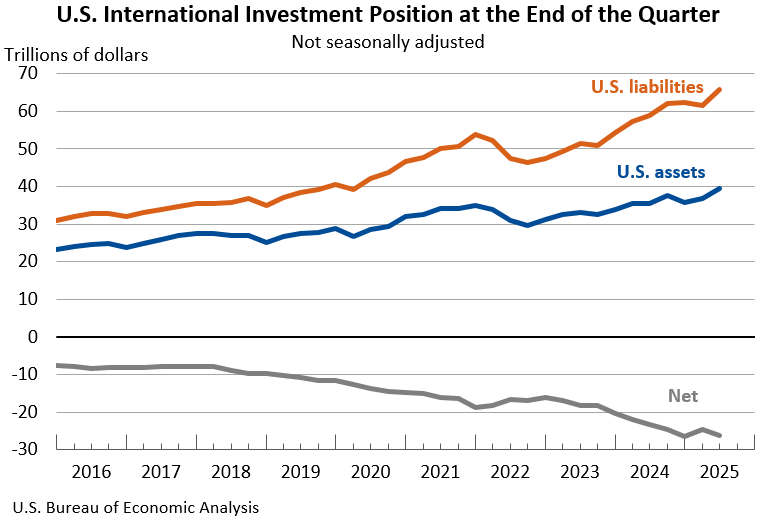Notice
Due to a lapse in appropriations, this website is not being updated.
Bureau of Economic Analysis
U.S. International Investment Position, 2nd Quarter 2025
The U.S. net international investment position, the difference between U.S. residents’ foreign financial assets and liabilities, was -$26.14 trillion at the end of the second quarter of 2025, according to statistics released today by the U.S. Bureau of Economic Analysis. Assets totaled $39.56 trillion, and liabilities were $65.71 trillion. At the end of the first quarter, the net investment position was -$24.65 trillion (revised).
Principal Federal Economic Indicators
Noteworthy
The Latest
Gross Domestic Product by State, 4th Quarter 2020 and Annual 2020 (Preliminary)
Real gross domestic product (GDP) increased in all 50 states and the District of Columbia in the fourth quarter of 2020, as real GDP for the nation increased at an annual rate of 4.3 percent. The percent change in real GDP in the fourth quarter ranged from 9.9 percent in South Dakota to 1.2 percent in the District of Columbia.
Personal Income and Outlays, February 2021
Personal income decreased $1,516.6 billion, or 7.1 percent at a monthly rate, while consumer spending decreased $149.0 billion, or 1.0 percent, in February. Economic impact payments associated with the Coronavirus Response and Relief Supplemental Appropriations (CRRSA) Act of 2021 (which was enacted on December 27, 2020) declined sharply in February and unemployment benefits continued, but at a lower level.
Personal Income and Outlays, February 2021
Personal income decreased $1,516.6 billion, or 7.1 percent at a monthly rate, while consumer spending decreased $149.0 billion, or 1.0 percent, in February.
Gross Domestic Product (Third Estimate), Corporate Profits, and GDP by Industry, Fourth Quarter and Year 2020
Real gross domestic product (GDP) increased at an annual rate of 4.3 percent in the fourth quarter of 2020, reflecting both the continued economic recovery from the sharp declines earlier in the year and the ongoing impact of the COVID-19 pandemic, including new restrictions and closures that took effect in some areas of the United States. The increase was 0.2 percentage point higher than the “second” estimate released in February. In the…
Gross Domestic Product, (Third Estimate), GDP by Industry, and Corporate Profits, Fourth Quarter and Year 2020
Real gross domestic product (GDP) increased at an annual rate of 4.3 percent in the fourth quarter of 2020, reflecting both the continued economic recovery from the sharp declines earlier in the year and the ongoing impact of the COVID-19 pandemic, including new restrictions and closures that took effect in some areas of the United States. The increase was 0.2 percentage point higher than the “second” estimate released in February. In the third…
Personal Income by State, 2020
State personal income increased 6.1 percent in 2020 after increasing 3.9 percent in 2019. In 2020, the increase in transfer receipts was the leading contributor to personal income growth in all states and the District of Columbia. The percent change in personal income across all states ranged from 8.4 percent in Arizona and Montana to 2.4 percent in Wyoming.
State Annual Personal Income, 2020 (Preliminary) and State Quarterly Personal Income, 4th Quarter 2020
State personal income increased 6.1 percent in 2020 after increasing 3.9 percent in 2019. In 2020, the increase in transfer receipts was the leading contributor to personal income growth in all states and the District of Columbia. The percent change in personal income across all states ranged from 8.4 percent in Arizona and Montana to 2.4 percent in Wyoming.
U.S. Current Account Deficit Widens in 2020
The U.S. current account deficit, which reflects the combined balances on trade in goods and services and income flows between U.S. residents and residents of other countries, widened by $167.0 billion, or 34.8 percent, to $647.2 billion in 2020. The widening mostly reflected reduced surpluses on primary income and on services and an expanded deficit on goods. The 2020 deficit was 3.1 percent of current dollar gross domestic product, up from…
U.S. Current Account Deficit Widens in Fourth Quarter 2020
The U.S. current account deficit, which reflects the combined balances on trade in goods and services and income flows between U.S. residents and residents of other countries, widened by $7.6 billion, or 4.2 percent, to $188.5 billion in the fourth quarter of 2020. The widening mostly reflected an expanded deficit on goods and a reduced surplus on services that were partly offset by a reduced deficit on secondary income. The fourth quarter…
U.S. International Transactions, Fourth Quarter and Year 2020
The U.S. current account deficit widened by $7.6 billion, or 4.2 percent, to $188.5 billion in the fourth quarter of 2020, according to statistics from the U.S. Bureau of Economic Analysis. The revised third quarter deficit was $180.9 billion. The fourth quarter deficit was 3.5 percent of current dollar gross domestic product, up from 3.4 percent in the third quarter.




